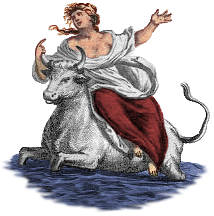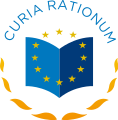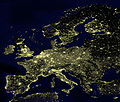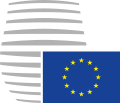Portal:European Union
Introduction
The European Union (EU) is a supranational political and economic union of 27 member states that are located primarily in Europe. The Union has a total area of 4,233,255 km2 (1,634,469 sq mi) and an estimated total population of over 448 million. The EU has often been described as a sui generis political entity (without precedent or comparison) combining the characteristics of both a federation and a confederation. Containing 5.8% of the world population in 2020, EU member states generated a nominal gross domestic product (GDP) of around US$16.6 trillion in 2022, constituting approximately one sixth of global nominal GDP. Additionally, all EU states except Bulgaria have a very high Human Development Index according to the United Nations Development Programme. Its cornerstone, the Customs Union, paved the way to establishing an internal single market based on standardised legal framework and legislation that applies in all member states in those matters, and only those matters, where the states have agreed to act as one. EU policies aim to ensure the free movement of people, goods, services and capital within the internal market; enact legislation in justice and home affairs; and maintain common policies on trade, agriculture, fisheries and regional development. Passport controls have been abolished for travel within the Schengen Area. The eurozone is a group composed of the 20 EU member states that have fully implemented the economic and monetary union and use the euro currency. Through the Common Foreign and Security Policy, the union has developed a role in external relations and defence. It maintains permanent diplomatic missions throughout the world and represents itself at the United Nations, the World Trade Organization, the G7 and the G20. Due to its global influence, the European Union has been described by some scholars as an emerging superpower. In 2012, the EU was awarded the Nobel Peace Prize. The United Kingdom became the only member state to leave the EU, in 2020; ten countries are aspiring or negotiating to join it. (Full article...) Selected article The flag of Portugal consists of a rectangle vertically divided into green, at the hoist, and red, at the fly, with the minor version of the national coat of arms (armillary sphere and Portuguese shield) centered over the boundary between the colors. It was officially adopted on 30 June 1911, replacing the flag used under the constitutional monarchy, after it was chosen among several proposals by a special commission, whose members included Columbano Bordalo Pinheiro, João Chagas and Abel Botelho. The current flag represents a sweeping change in the evolution of the Portuguese flag, which was always intimately associated with the royal arms. Since the country's foundation, the national flag developed from King Afonso I's blue-cross-on-white armorial square banner to the liberal monarchy's royal arms over a blue-and-white rectangle. In between, major changes associated with important political events contributed to the evolution of the national shield into its current design. Selected picturePainting: Claude Monet The Garden at Sainte-Adresse is an oil-on-canvas painting by the French impressionist painter, Claude Monet. It was painted in 1867 in the French resort town of Sainte-Adresse, where Monet was spending the summer. The models were probably Monet's father Adolphe, his cousin Jeanne Marguerite Lecadre, her father Adolphe Lecadre, and perhaps Lecadre's other daughter, Sophie, the woman seated with her back to the viewer. The painting is composed with flat horizontal bands of colour, which were reminiscent of Japanese colour wood-block prints. The Garden at Sainte-Adresse is now in the Metropolitan Museum of Art in New York City.
Did you know?...that Romania and Bulgaria became full members of the European Union on January 1, 2007? ...that the European Union's member states combined represent the world's largest economy by GDP, larger than the United States, the People's Republic of China, and Japan, the seventh largest territory in the world by area and the third largest by population after China and India? Selected cityAthens is the capital and largest city of Greece. Named after goddess Athena, Athens is a cosmopolitan metropolis with a population of 3.7 million people. The Athens metropolitan area constitutes the center of economic, financial, industrial, cultural and political life in Greece. The city is also rapidly becoming a business center in the European Union. Ancient Athens was a powerful polis city-state and a renowned center of learning, home of Plato's Academy and Aristotle's Lyceum. It is often referred to as the cradle of Western civilization, largely due to the impact of its cultural and political achievements during the 5th and 4th centuries BCE on the rest of the then known European Continent. The classical era heritage is still evident in the city, portrayed through a number of ancient monuments and artworks, the most famous being the Parthenon on the Acropolis. Athens was the host city of the first modern-day Olympic Games and, more recently, of the 2004 Summer Olympics. General imagesThe following are images from various European Union-related articles on Wikipedia.
TopicsFeatured contentFeatured articles
Featured lists
Featured contentGood articles
CategoriesRelated portalsAssociated WikimediaThe following Wikimedia Foundation sister projects provide more on this subject:
Discover Wikipedia using portals |
































































